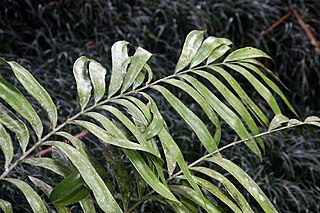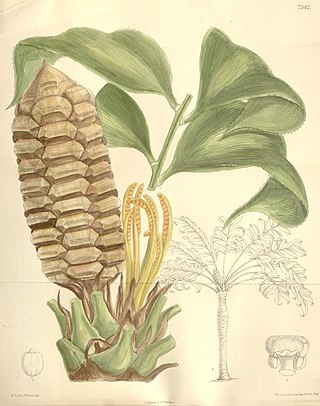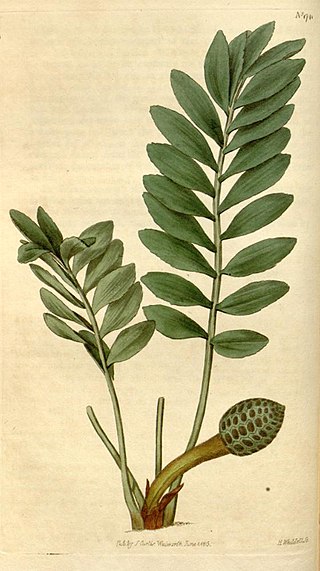
Zamia is a genus of cycad of the family Zamiaceae, native to North America from the United States throughout the West Indies, Central America, and South America as far south as Bolivia. The genus is considered to be the most ecologically and morphologically diverse of the cycads, and is estimated to have originated about 68.3 million years ago.

Zamia acuminata is a species of plant in the family Zamiaceae which is threatened by habitat loss. It is found in Costa Rica and Panama.
Zamia amplifolia is a species of plant in the family Zamiaceae. It is endemic to the Calima River watershed of Valle del Cauca Department, Colombia.

Zamia angustifolia is a species of plant in the genus Zamia. It is found in the Bahamas, where it is threatened by habitat loss, and in Cuba, where it is abundant.

Zamia chigua is a species of plant in the family Zamiaceae. It is found in Colombia and Panama. Its natural habitat is subtropical or tropical moist lowland forests.
Zamia lucayana is a species of plant in the family Zamiaceae, part of the Zamia pumila species complex. It is endemic to the Bahamas, and is endangered by habitat loss. Z. lucayana is known locally as "bay rush".

Zamia manicata is a species of plant in the family Zamiaceae. It is found in Colombia and Panama. Its natural habitat is subtropical or tropical moist lowland forests.

Zamia obliqua is a species of plant in the family Zamiaceae. A common name is "chigua". It is found in Colombia and Panama. Its natural habitat is subtropical or tropical moist lowland forests. It is threatened by habitat loss.

Zamia pseudoparasitica is a species of plant in the family Zamiaceae. It is endemic to Panama.

Zamia pygmaea is a species of plant in the family Zamiaceae found only in Cuba. It is the smallest living cycad. It is listed as critically endangered on the IUCN Red List based on its limited distribution, severely fragmented habitat, and population of less than 250 mature individuals.

Zamia roezlii (chigua) is a species of cycad, a palm-like pachycaulous plant in the family Zamiaceae. It is found in Colombia and the Pacific coast of Ecuador. It is named for the Czech botanist Benedikt Roezl. A single sperm cell from Zamia roezlii is about 0.4 mm in length and is visible to the unaided eye, being the world's largest plant sperm cell. Drosophila bifurca, a species of fruit fly, has sperm that are 5.8 cm long, albeit mostly coiled tail. The tree is up to 22 feet in height with fronds up to ten feet long bearing leaflets up to twenty inches long and six inches wide.

Zamia standleyi is a species of plant in the family Zamiaceae. It is endemic to Honduras, and is threatened by habitat loss.

Zamia erosa is a species of cycad native to the Caribbean islands of Jamaica, Cuba, and Puerto Rico, described by Orator Fuller Cook and Guy N. Collins in 1903. The species formerly known as Z. amblyphyllidia was determined in 2010 to be the same species as Z. erosa. It is listed as vulnerable by the IUCN Red List.
Zamia hamannii is a species of cycad in the family Zamiaceae. The only known population grows in a small area on an island on the northwestern Caribbean coast of Panama. Most plants of the species grow in forest, but some live on sandy beaches. It was named and described in 2008.
Zamia nesophila, common name "guade teet", is a species of cycad in the family Zamiaceae. It is endemic to several islands in northwestern Panama. Most plants grow on sandy beachs close to the sea, although some grow inland in forests. The species is critically endangered due to seaside development.
Zamia katzeriana is a species of cycad in the family Zamiaceae, endemic to Tabasco and Chiapas states, Mexico.
Zamia huilensis is a species of cycad in the family Zamiaceae. Its common name is palma de monte.
Zamia nana is a species of plant in the family Zamiaceae. It is found in Coclé Province in Panama.

Zamia integrifolia, also known as coontie, is a small, tough, woody cycad native to the southeastern United States, the Bahamas, Cuba, the Cayman Islands, and Puerto Rico.












